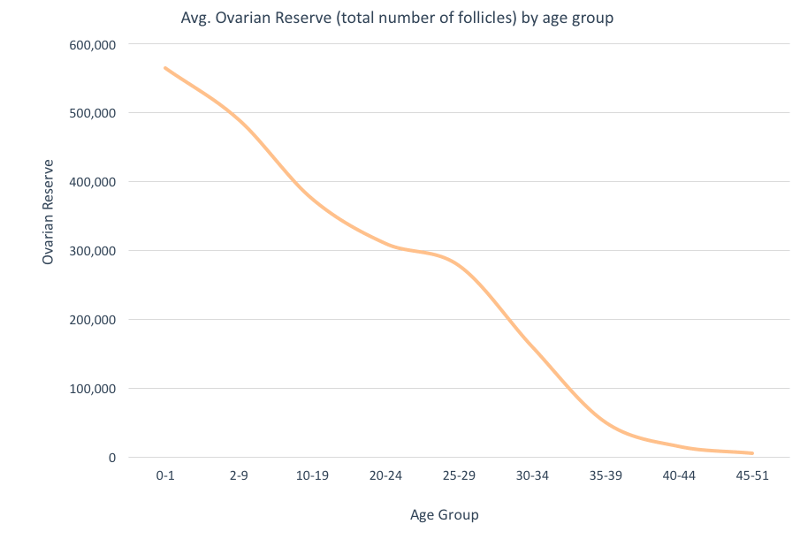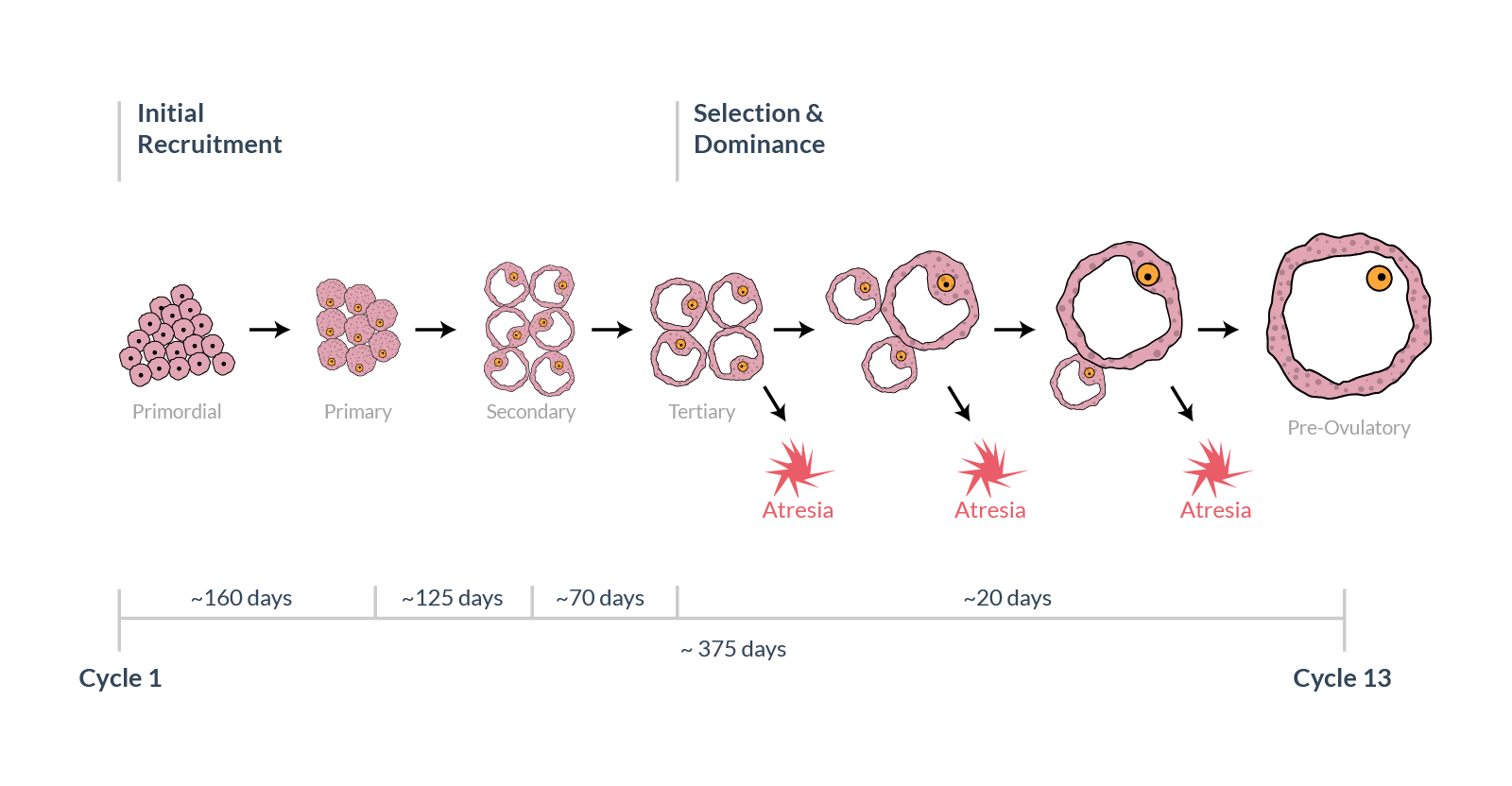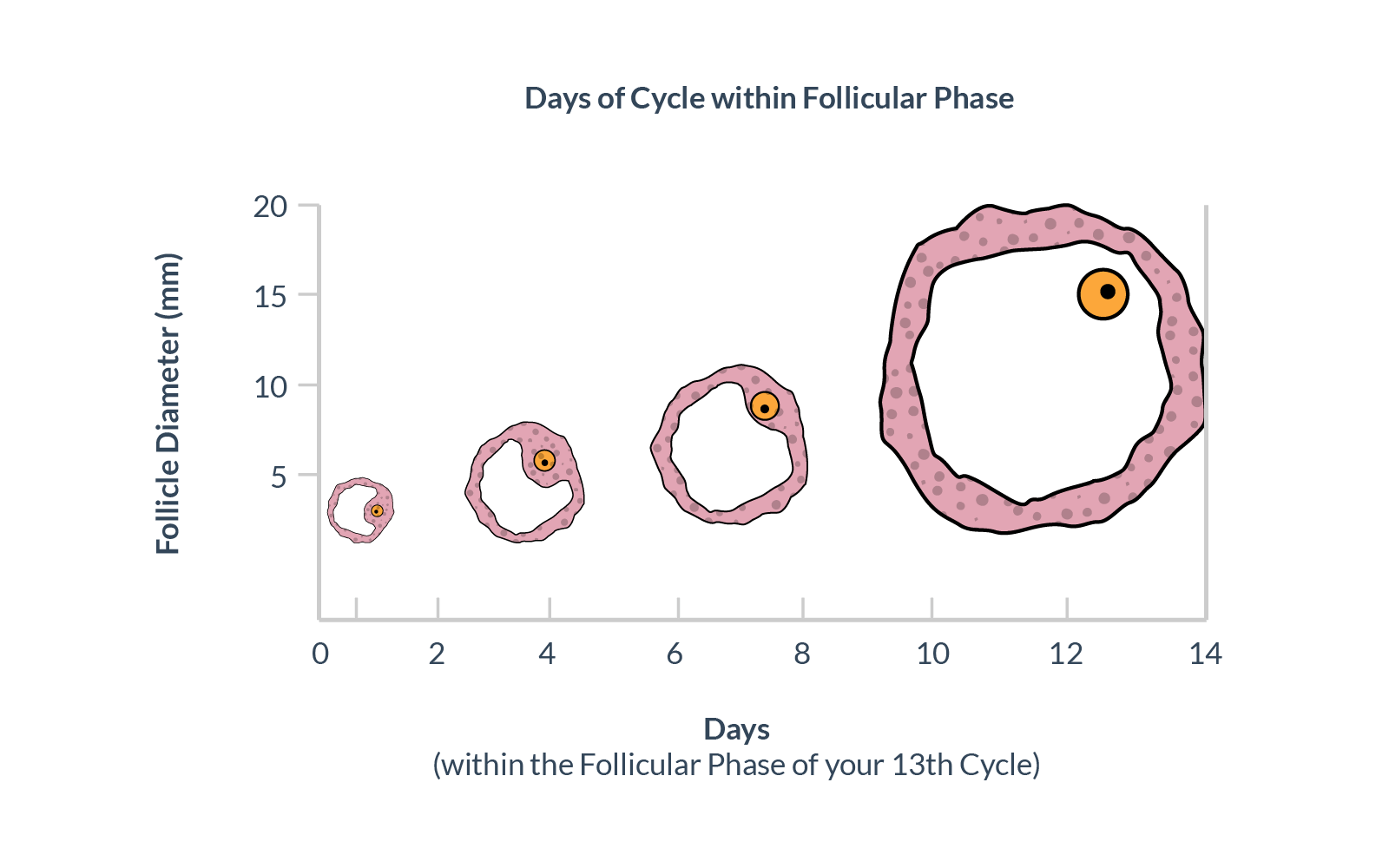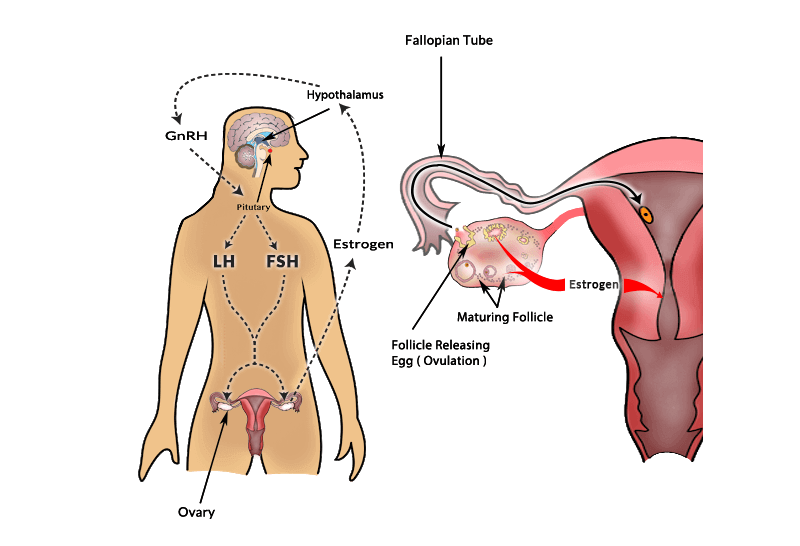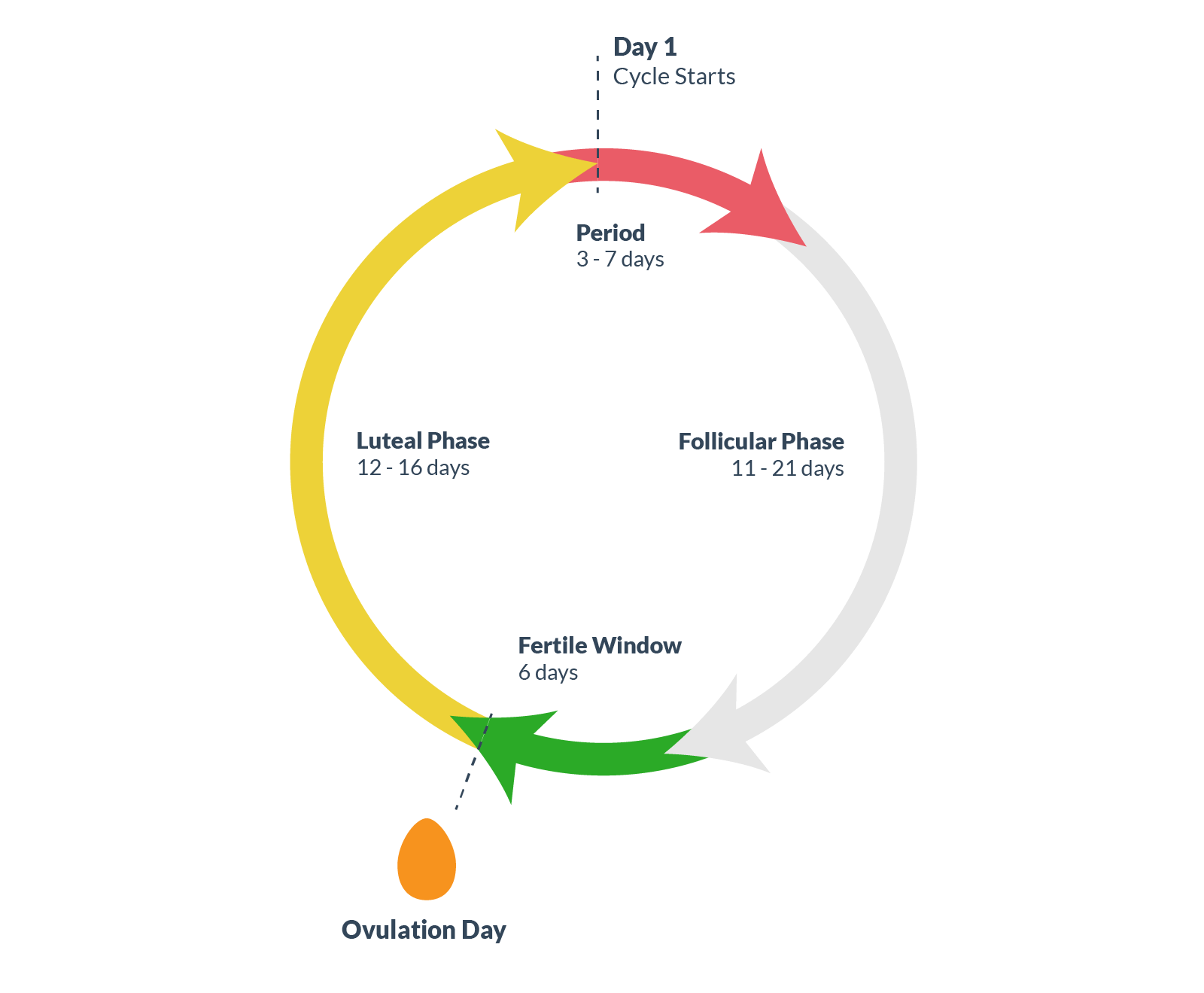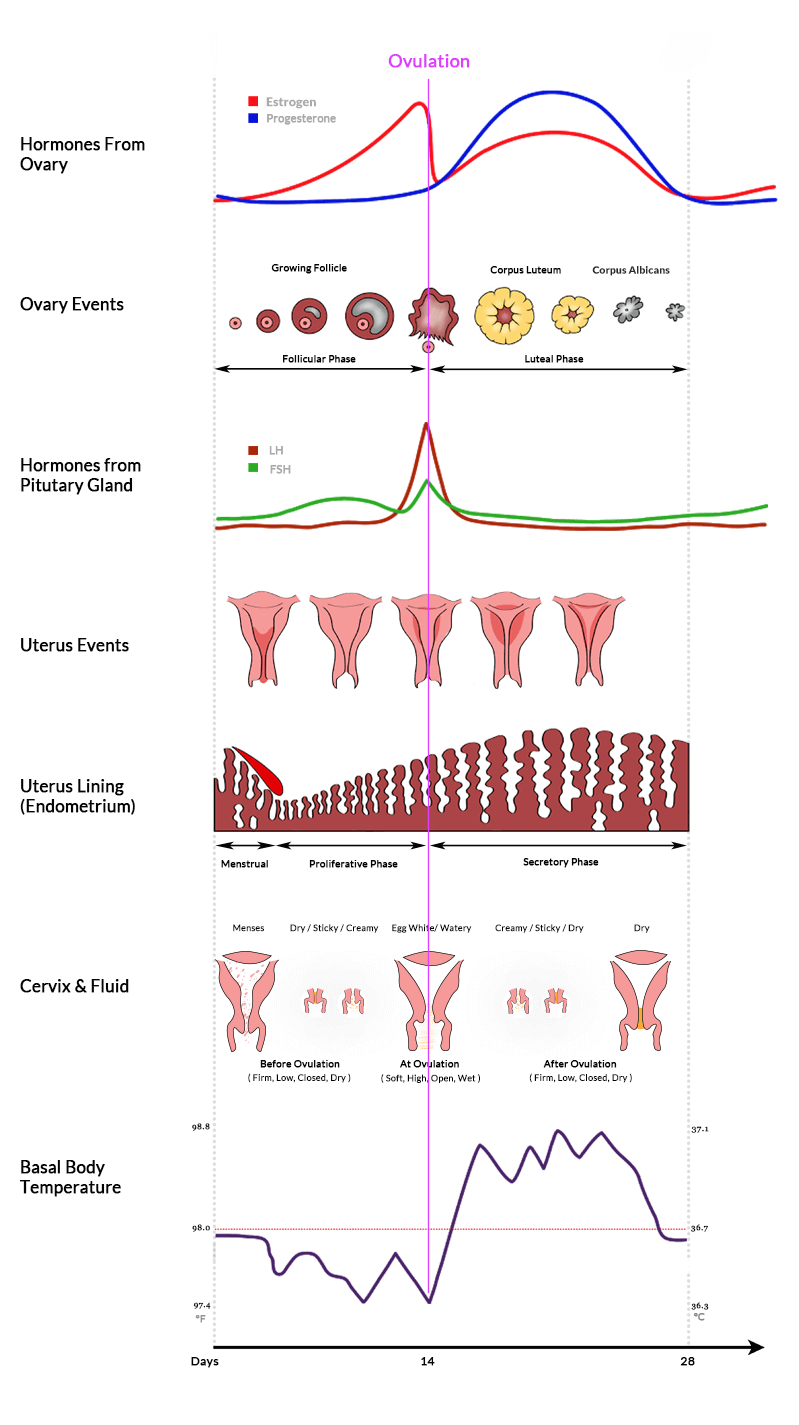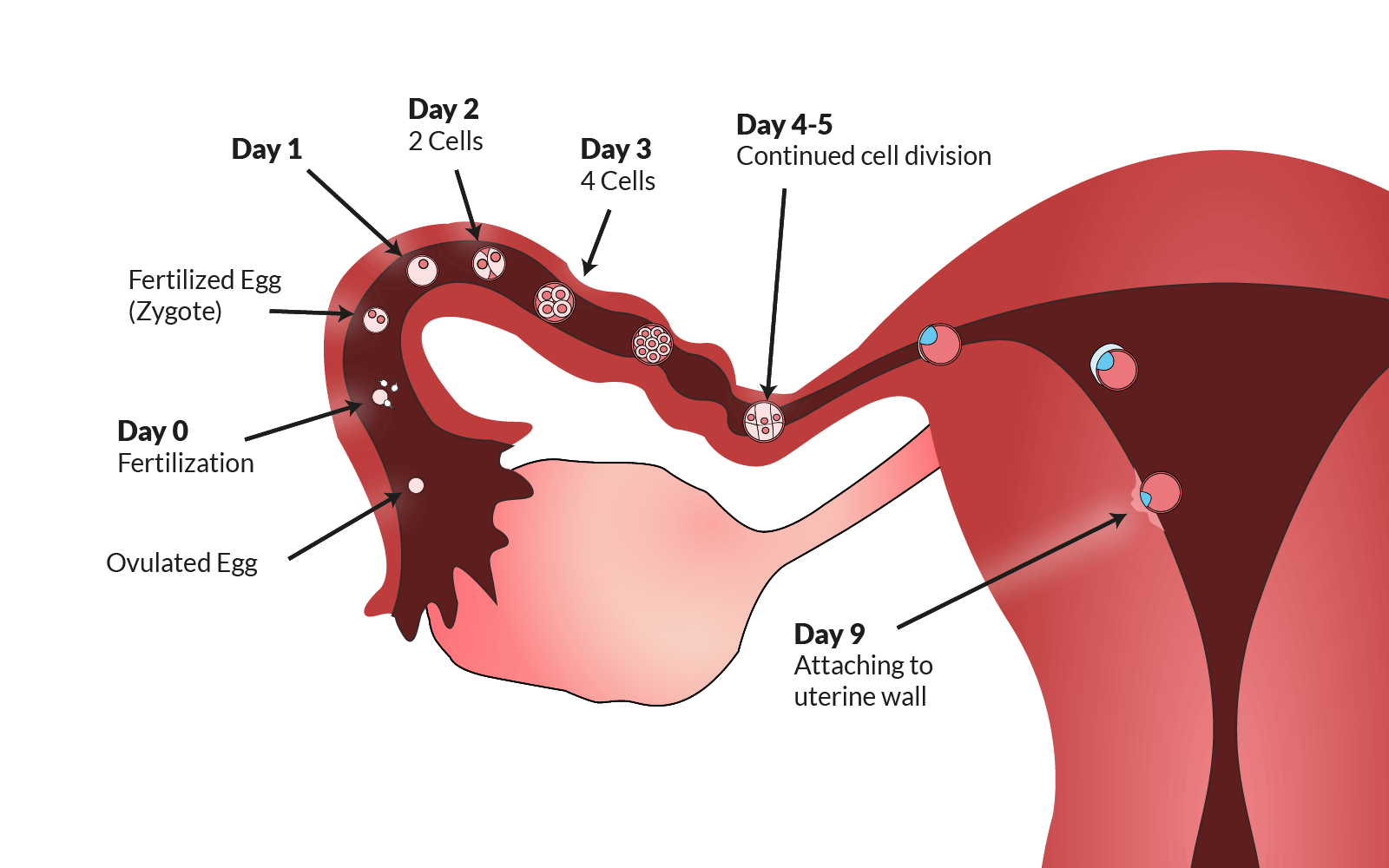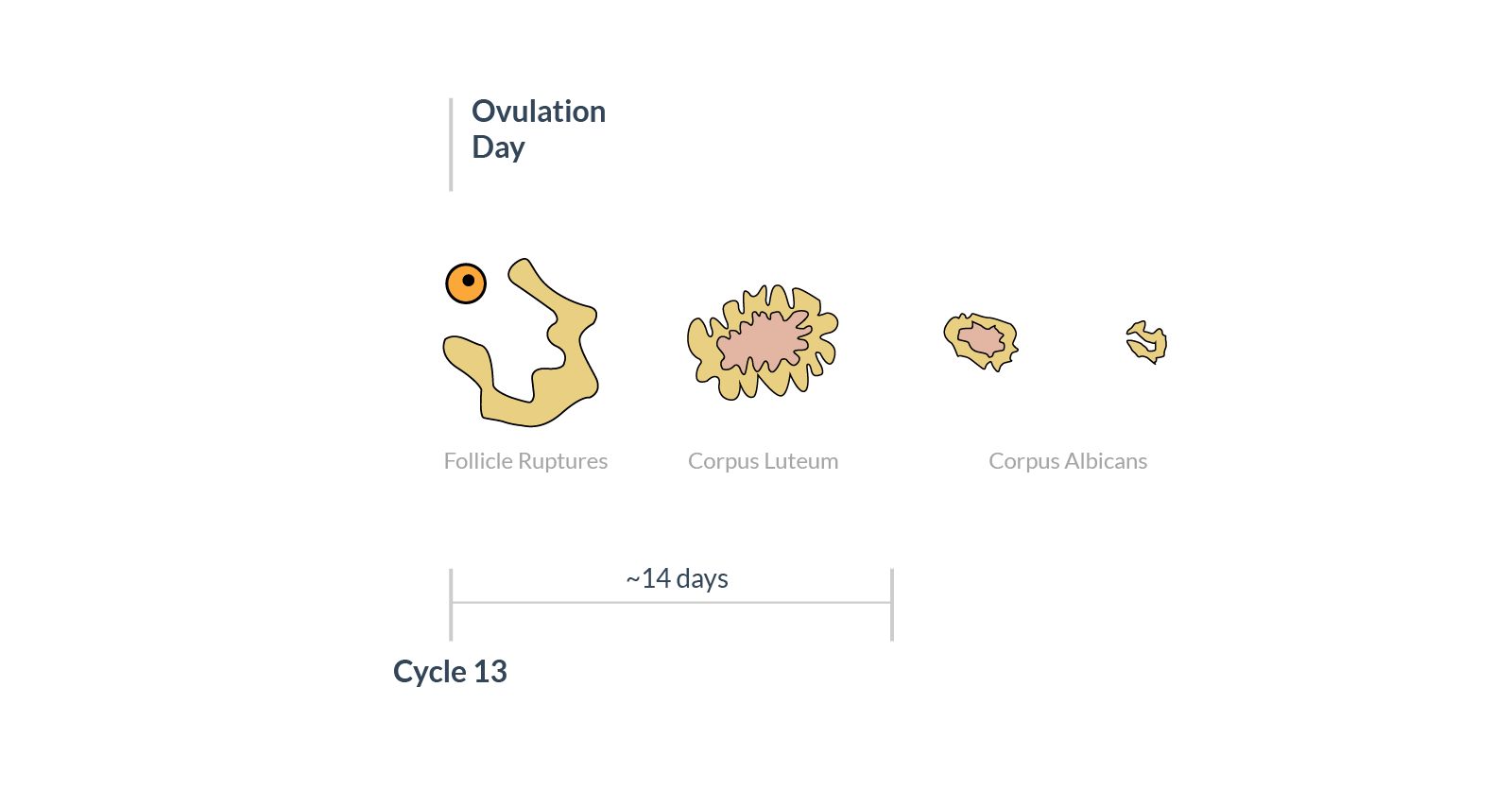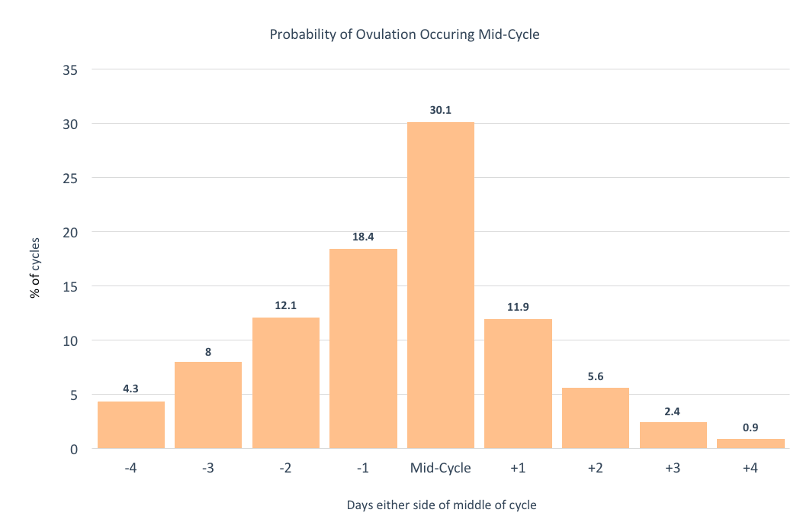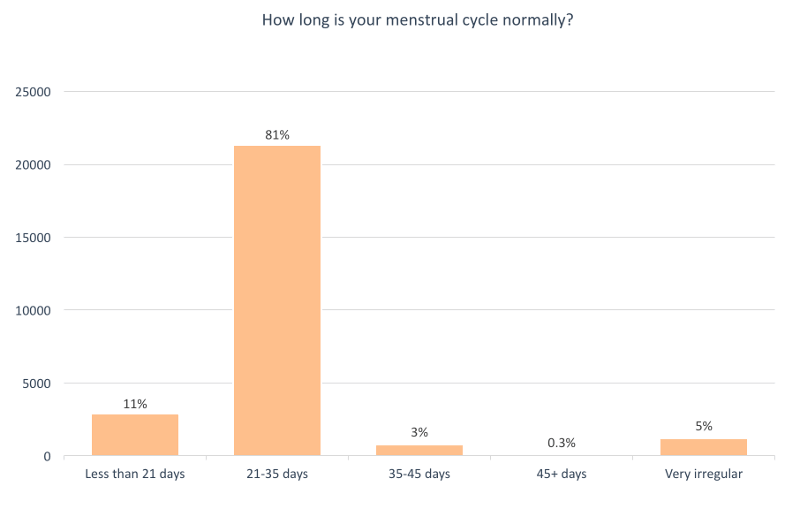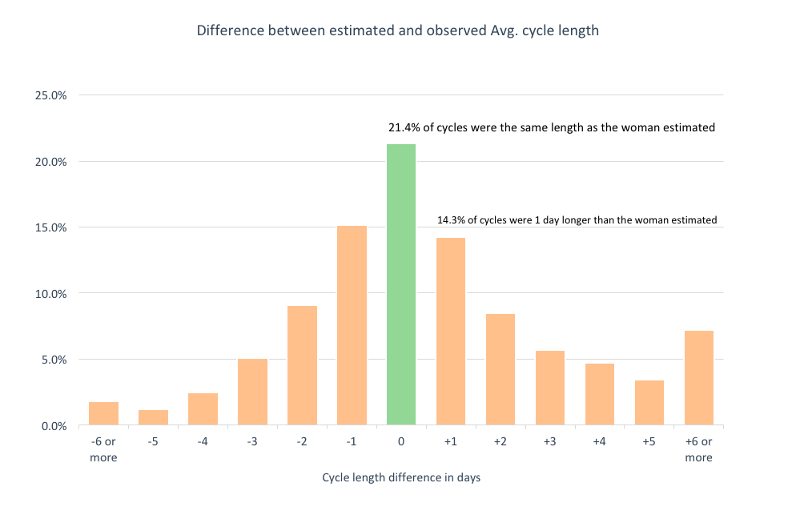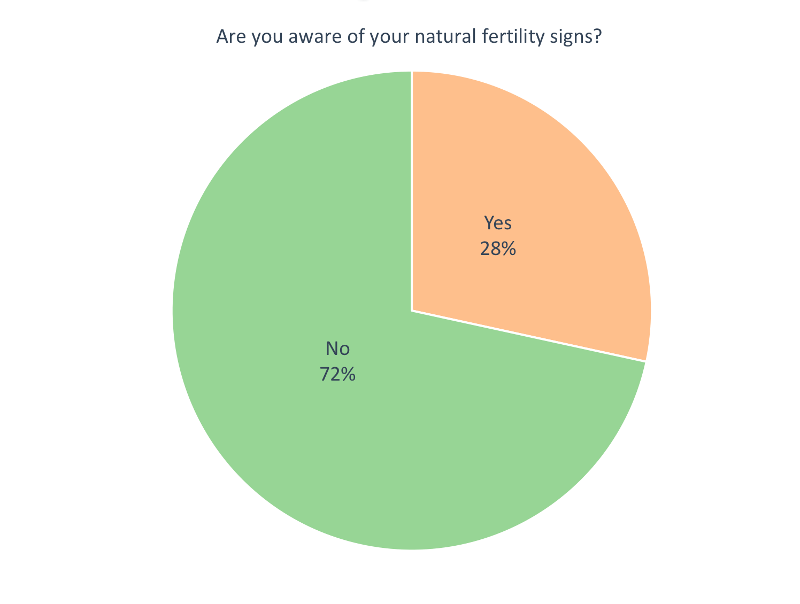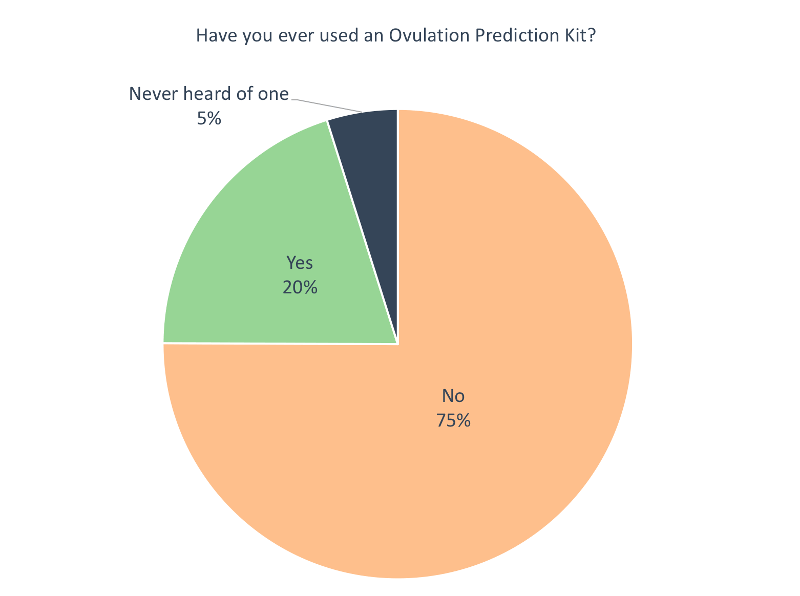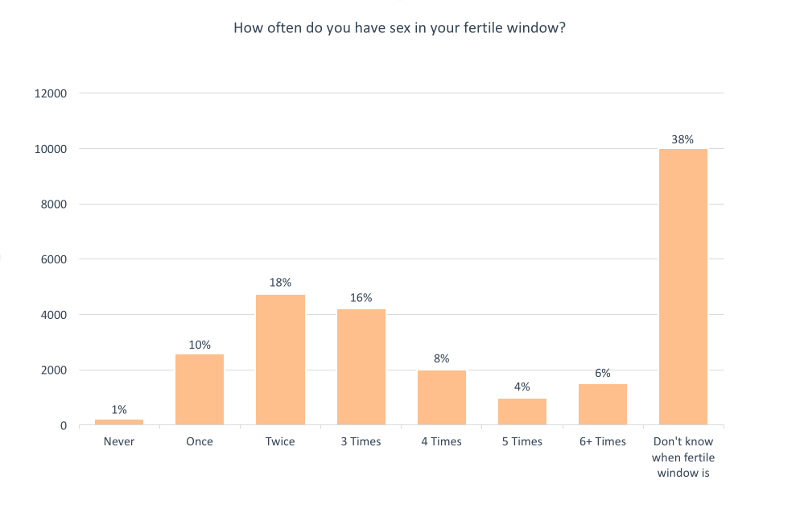Sure, our Ovulation Calculator app can help you get pregnant... BUT it helps significantly to understand ovulation.
No app can know your body like you do and this is why I spend so much time providing education to our members. It's the combination of knowledge and predictions that helps women that use Ovulation Calculator get pregnant faster.
If you're trying to get pregnant, I encourage you to read all of this simple to understand article about ovulation.
What is ovulation?
Put simply, ovulation is the release of an egg from an ovary. The egg then slowly moves through the fallopian tube towards the uterus.
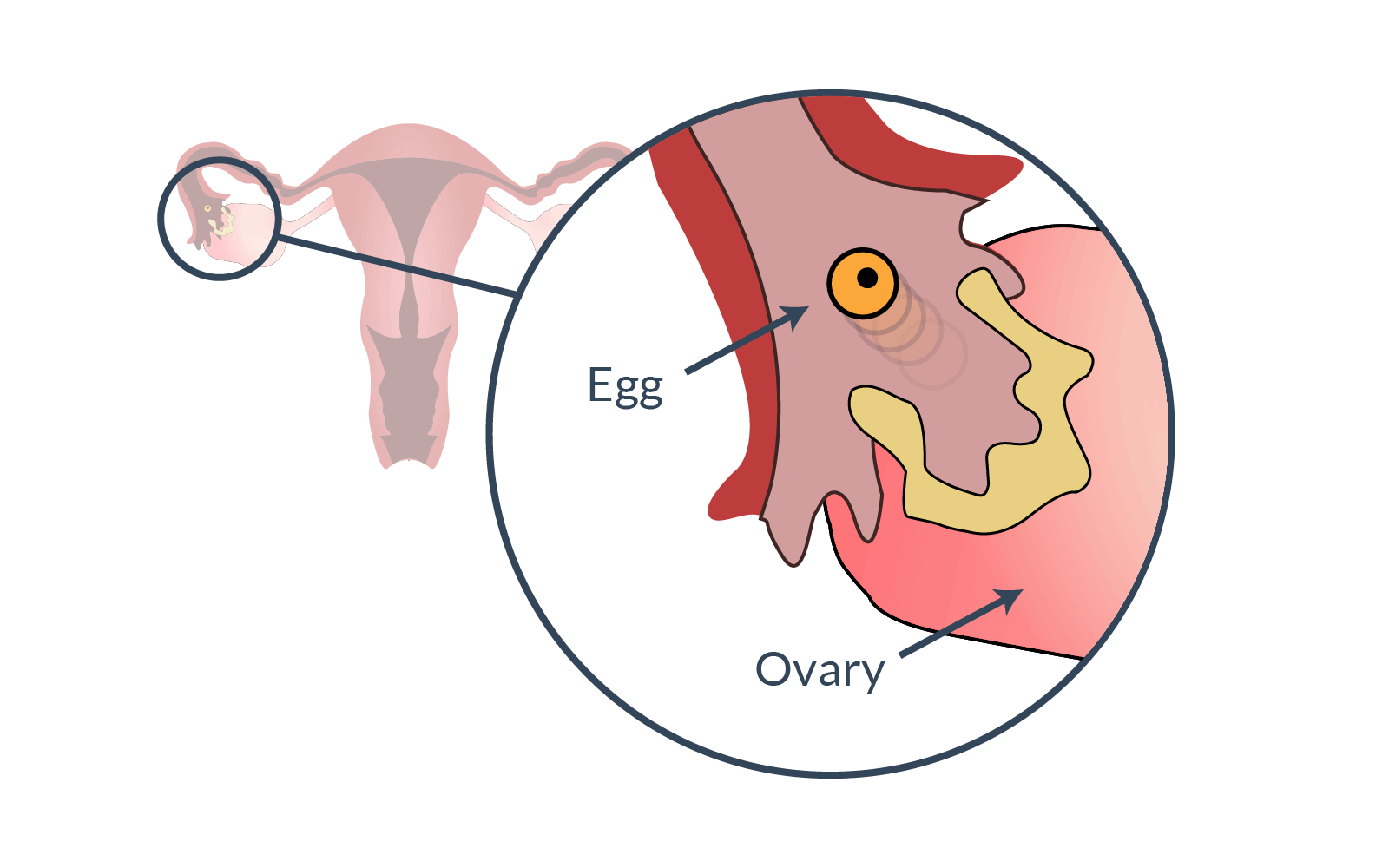
If the egg is fertilized by sperm along the way, it will attach to the lining of the uterus (implantation) where it begin its development as a fetus. If sperm doesn't fertilize the egg, it will die in the fallopian tube and dissolve. Without implantation, the lining of the uterus will shed, causing a period to occur.
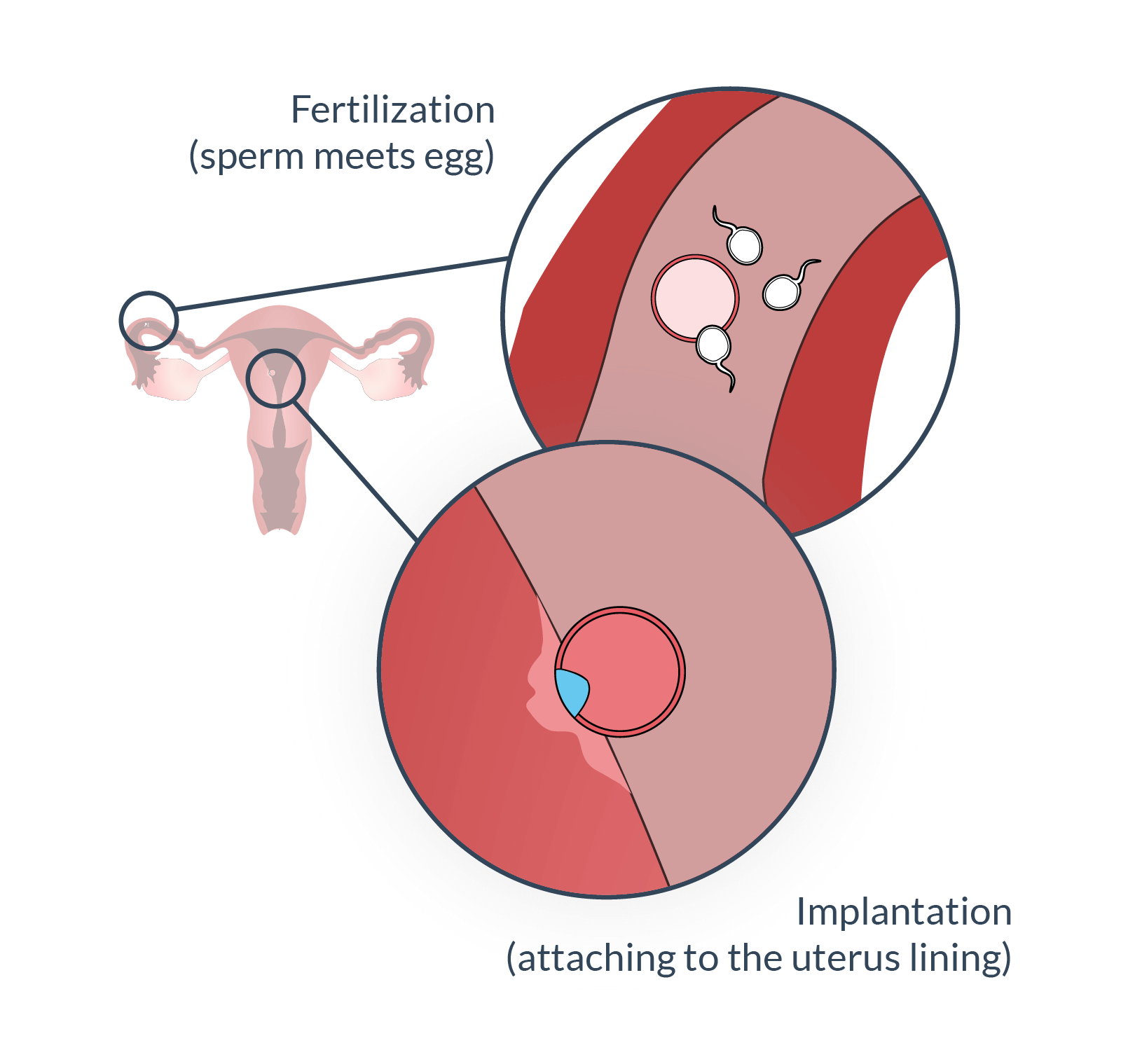
Women are born with two ovaries and two fallopian tubes (left and right). See the image below.
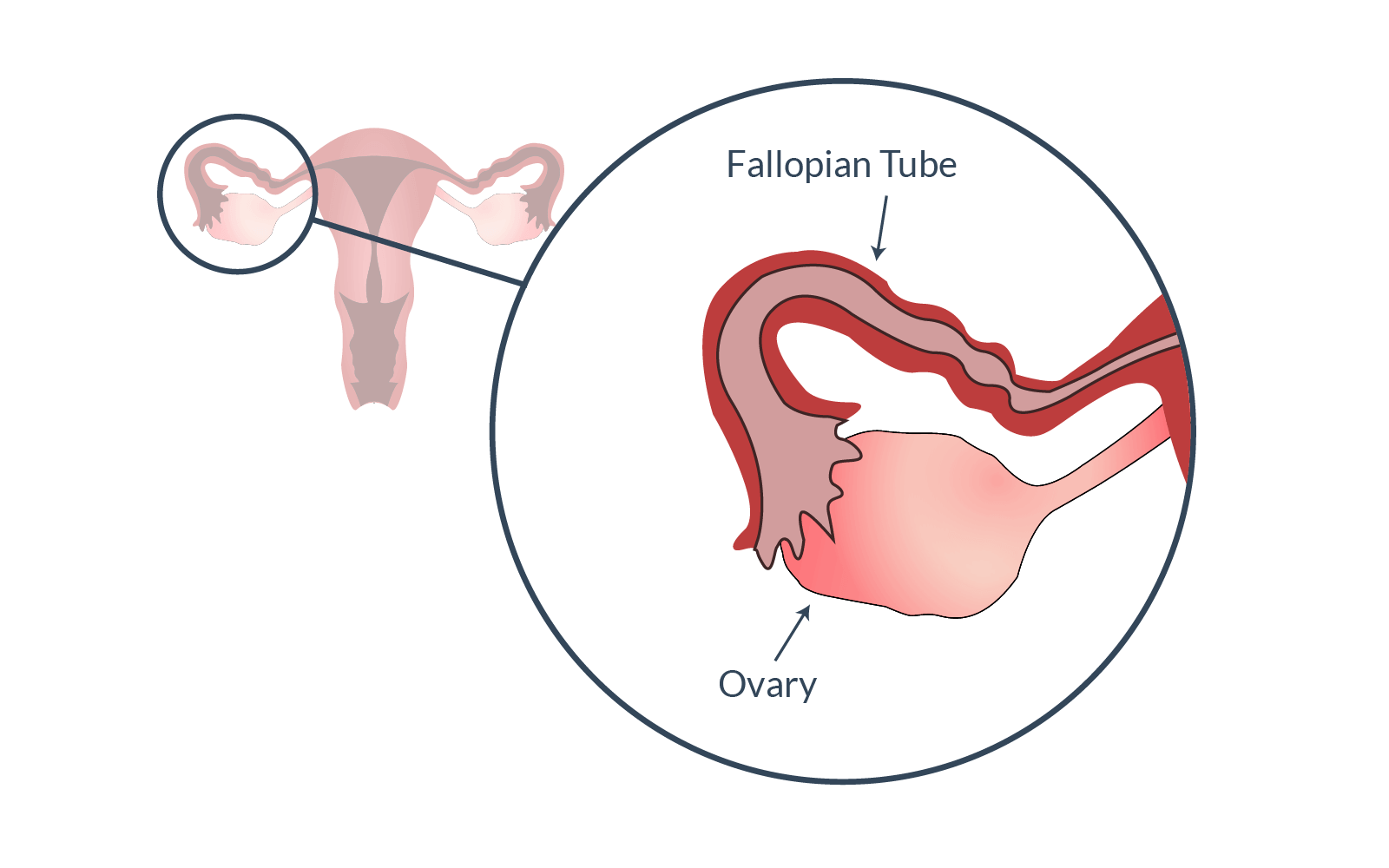
Under normal circumstances only one ovary will release an egg (ovum) per menstrual cycle. Ovulation appears to happen randomly from the left or right ovary. Occasionally eggs are ovulated (released) from both ovaries, which is how fraternal (non-identical) twins can occur.
- Ovulation is when an egg is released from an ovary.
- Only one ovary releases an egg usually.
- It happens randomly from the left or right ovary.
- After leaving the ovary, the egg can be fertilized by a sperm in the fallopian tube.
To understand ovulation in depth we need to go back to when you were in your mother's womb...
Follicles and egg cells
Prior to ovulation, the egg has to be nurtured and developed within a structured environment that's perfect for egg development. This structure is called a follicle, a fluid-filled sac containing a microscopic immature egg cell (oocyte).
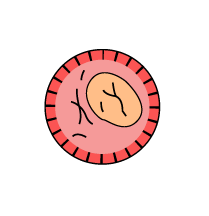
Before you were even born
All of your follicles (eggs) were formed in your ovaries before your were born, during about the 4th month of your fetal life1. At birth you have about 400,000 follicles per ovary2.
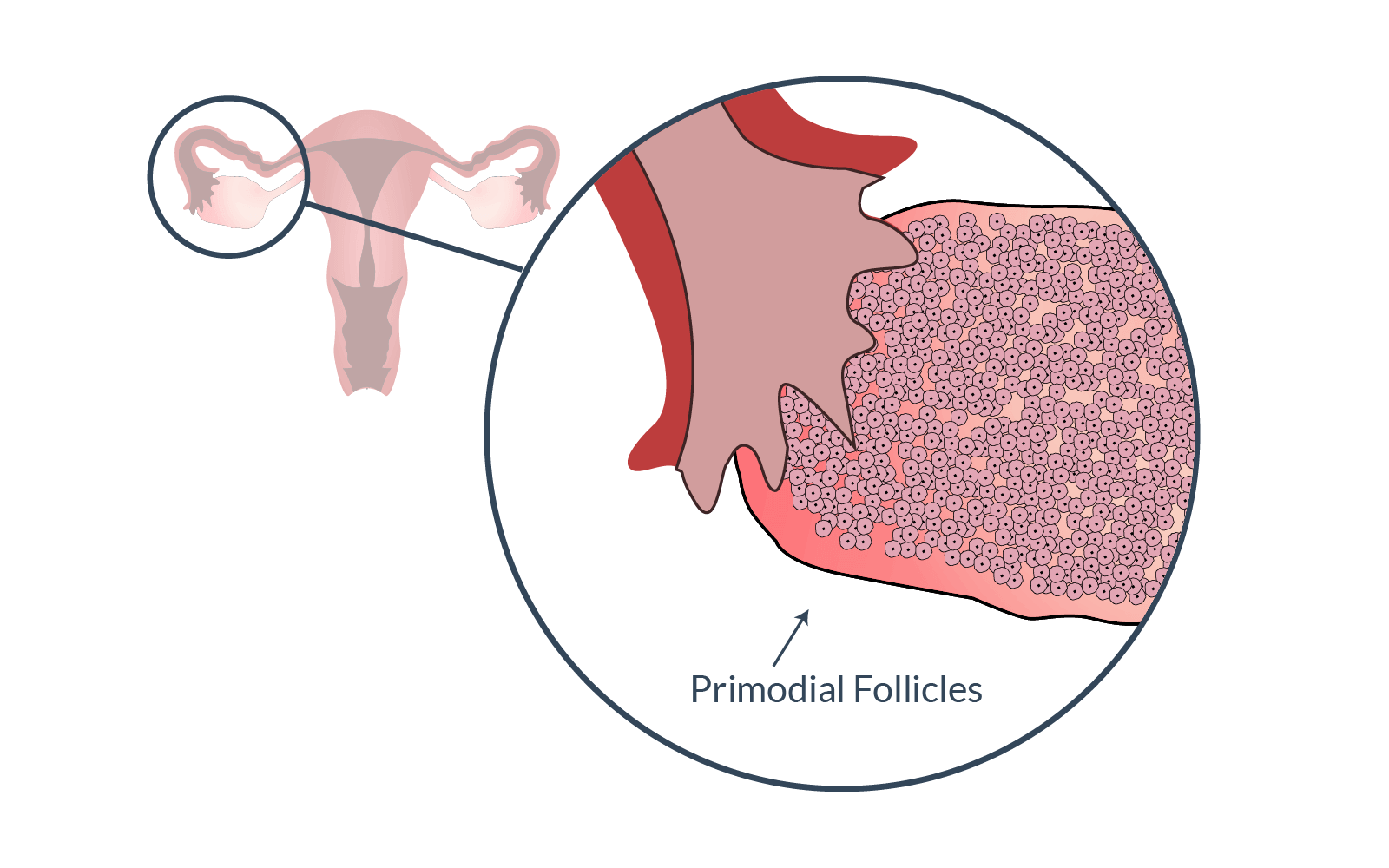
Each follicle has the potential to release an egg during ovulation, but only about 400 will actually reach this stage in your lifetime. The rest are lost (die) in a process called atresia.
The total number of follicles remaining at any given time is known as the ovarian reserve and it slowly declines at a steady rate up until the age of about 37, or when the ovarian reserve has reduced to having only 25,000 follicles. After this, the rate of decline doubles until only about 1,000 remain at menopause3.
In a 2007 study4, researchers counted the ovarian reserve of 122 women aged between 0 and 51. See the graph below for a visual representation of the average ovarian reserve by age group.
Section Summary
- You were born with all the follicles you will ever have (about 400,000 per ovary).
- Each follicle contains an immature egg.
- Out of the hundreds of thousands of follicles you were born with, only about 400 release an egg (400 ovulations), the rest die trying.
- Your follicle reserve (ovarian reserve) declines until menopause.
Follicle recruitment and development
After your follicles are formed (before birth), they stop developing and lie dormant (rest) before developing further. At this stage the follicles are called primordial follicles. Amazingly, these follicles can wait up to 50 years before being recruited to develop further. They have to go through many stages of development before becoming one of the 400 follicles that makes it all the way to the ovulation phase.
What is recruitment?
Follicles are recruited in groups or cohorts to further develop to the next stage. Effectively, recruitment is like a signal that allows follicles to continue growing rather than die5. The initial Recruitment is when a primordial follicle is stimulated to reinitiate development. It is the first step of follicle development, a process that takes over a year, or approximately 13 menstrual cycles.
This process of recruitment and development, which is regulated by hormones is called folliculogenesis. Approximately 1,000 primordial follicles are recruited in groups or cohorts per month, the goal being to produce a single dominant follicle that will release an egg during the ovulation phase.
Although follicle recruitment and development starts before birth, the main part of follicle development begins after puberty, as soon as a regular menstrual cycle is established.
- All of your follicles were made before you were born.
- They then stop developing and lie dormant until recruited.
- Each month, a pool of follicles (about 1,000) are recruited to develop further.
- Full development takes over a year and many stages.
- During each stage of development, only some follicles are recruited to continue to the next stage. The rest die.
Stages of follicle development before ovulation
There are several stages of development follicles must go through for an egg to mature.
Primordial (dormant) >> Primary >> Secondary >> Tertiary >> Pre-ovulatory
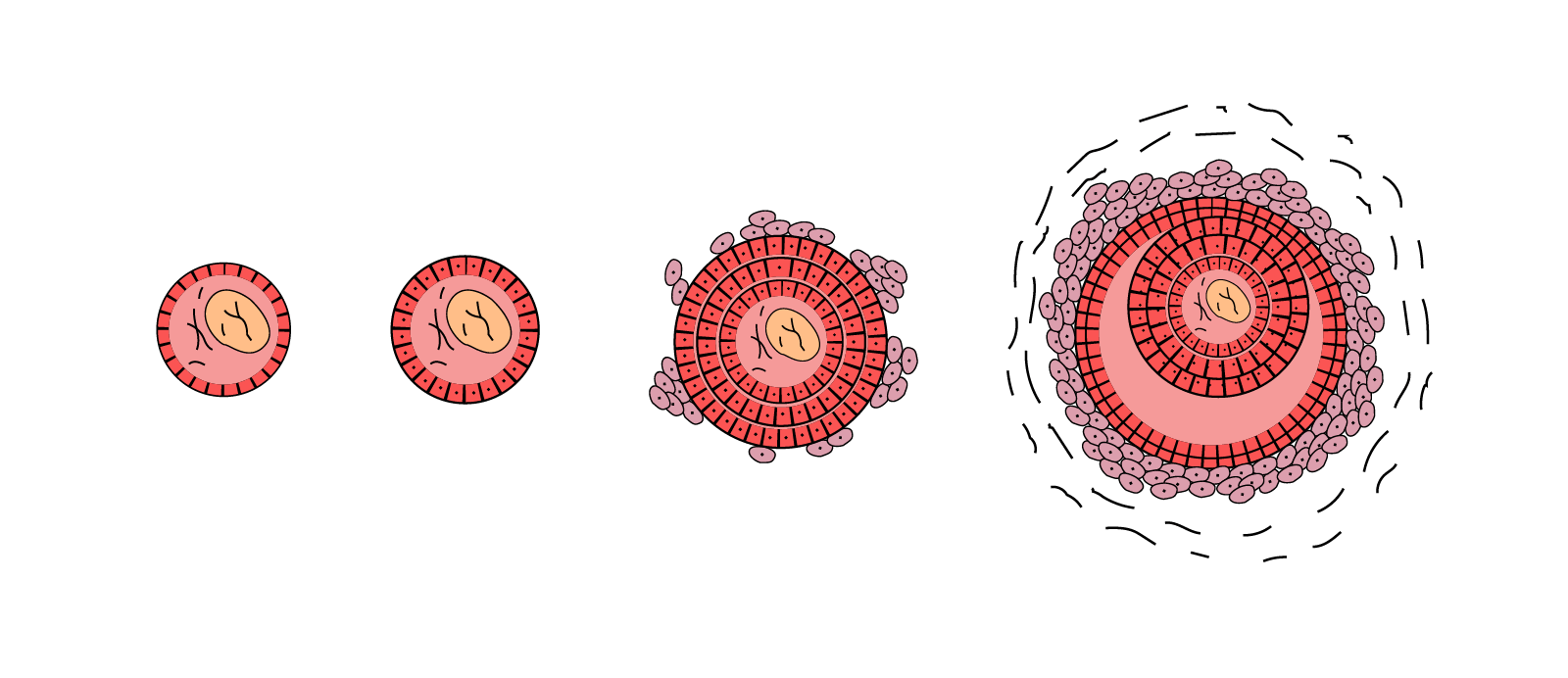
At any given time, your ovaries contain follicles at every stage of development. It takes roughly 375 days for a follicle to develop to ovulation stage.
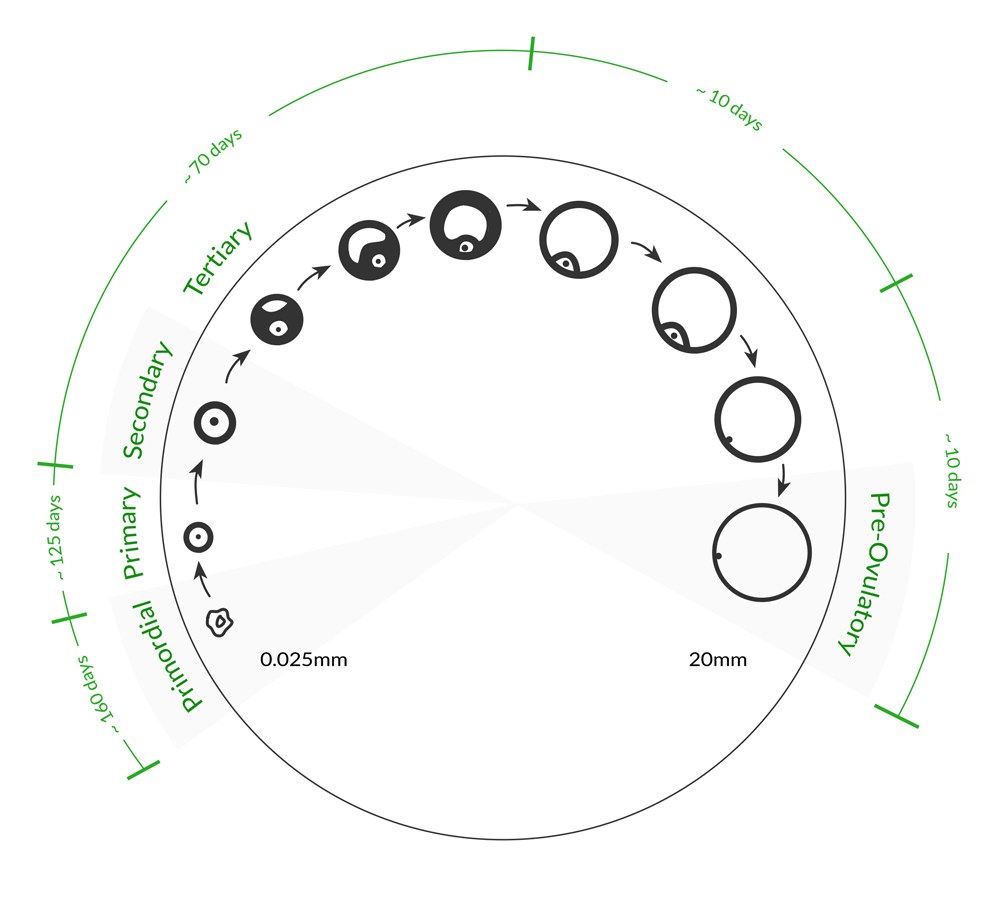
Each pool of recruited follicles is spread across both ovaries. The pool of follicles compete with each other for dominance (to be the follicle that releases an egg in ovulation). Over the next 12 cycles, most will die with just a few making it into the 13th cycle.
At the end of the 12th cycle (about 15 to 20 days before ovulation) a few follicles (about 5 per ovary) are recruited to participate in the 13th cycle. These follicles compete which each other for about a week, until one starts to outgrow the others6.
The others give up and die. The single dominant follicle (pre-ovulatory follicle) then quickly grows to over 20mm in diameter, causing it to rupture and release your egg cell (now matured) out of the ovary and into the fallopian tube - this is ovulation.
The pace of follicle development is often misrepresented, with many sources suggesting that a follicle develops only within the follicular phase (the first two weeks of the cycle). As mentioned, follicle development takes over a year. It is only during the follicular phase of 13th cycle that a follicle grows to pre-ovulatory stage.
- It takes several stages; over a period of 375 days (about 13 cycles) for a follicle to develop and reach pre-ovulatory stage.
- Each pool of follicles compete with each other for dominance (to be the single follicle that releases an egg).
- By the time the pool has reached the 13th cycle (the cycle in which one of them will release an egg), only a few of the pool remain.
- These follicles compete which other for the final time during the follicular phase of the 13th cycle.
- After about a week, one will start to outgrow the others, the others will die.
- The dominant follicle quickly grows to over 20mm and then ruptures - releasing an egg out of the ovary: "ovulation".
- Whilst all this is happening, other pools are also competing against each other for the next ovulation. At any given time your ovaries contain follicles at all stages of development.
Ovulation is controlled by hormones
Chemical messengers called hormones tightly control ovulation and the folliculogenesis process. A part of your brain called the pituitary gland is given signals to release follicle stimulating hormone (FSH) and luteinizing hormone (LH), which are released into the bloodstream and then act on the ovaries. Here is a summary of how hormones control follicle development and ovulation:
- The hypothalamus in your brain produces gonadotropin releasing hormone (GnRH). It acts on the pituitary gland in your brain to produce FSH and LH.
- FSH and LH act on the follicles in your ovaries to control folliculogenesis.
- As mentioned, folliculogenesis is a long process (over a year). Fast forward 360 days...
- We are now at the end of the 12th cycle, only a few follicles from the pool are left. These follicles compete with each other for FSH during the follicular phase of the 13th cycle.
- In response to an increase of FSH, the follicles produce estrogen.
- The follicles that have less FSH-receptors will stop developing.
- All but one stops growing. The remaining follicle (dominant follicle) quickly grows to over 20mm.
- The rising levels of estrogen reach a point that causes a rapid rise in LH known as the 'LH Surge'.
- This provides your maturing egg a final push to grow causing it to burst out of the follicle and ovary. This is ovulation.
Diagram showing where hormones move to control ovulation.
Ovulation is just one phase of the menstrual cycle
Menarche marks the beginning of the menstrual cycle and ovulation. Menarche means 'month' and 'beginning' in Greek and is the time when a female has her first menstrual bleeding (period). The average age of menarche is 12.5 years in the US7. By this age, girls are estimated to have only 180,000 follicles left per ovary8 (you start with 400,000 in each).
You usually ovulate once per menstrual cycle. A menstrual cycle can be best described as a pattern of changes that happen in both the ovary (called the ovarian cycle) and uterus (called the uterine cycle) simultaneously. Ovulation is one phase within the ovarian cycle.
The menstrual cycle is actually two cycles each containing 3 phases, they are;
Ovarian cycle: Follicular phase > Ovulation phase > Luteal phase
Uterine cycle: Menstruation phase > Proliferative phase > Secretory phase
However, most people commonly refer to the phases as per the below diagram:
Your cycle length is counted in days from the first day of your period, until the day before your next period. In a textbook cycle, ovulation occurs on day 14 of a 28-day cycle, but it's common to have cycles lasting anywhere from 18 to 45 days. It's ovulation that makes your cycle length differ... the day ovulation occurs within your cycle, determines how long your cycle is.
Many things happen simultaneously during your cycle: hormones are rising and falling, follicles are developing in the ovaries, the uterus sheds (menstrual bleeding) and builds a new lining, the cervix changes and produces cervical mucus, the dominant follicle releases a mature egg during ovulation and even your temperature changes.
To see how all these important functions work together to create ovulation, take a look at the table below. Note, this is based on a typical 28-day cycle. For longer or shorter cycles, the follicular phase events would happen over less or more days.
| Days | What's happening in the ovary? | What's happening in the uterus? | Hormones |
| 1-5 | Follicular phase - Follicles further develop and compete for dominance, one outgrows the others. | Menstruation phase - The inner lining of the uterus breaks and is shed as a discharge of blood. | LH and FSH act on ovaries to stimulate follicle growth. The follicles produce estrogen and progesterone. |
| 6-11 | Follicular phase - A single dominant follicle continues to grow - the egg inside is maturing and begins producing estrogen. | Proliferative phase - Estrogen causes a new uterus lining to grow in preparation for implantation. | The follicles produce estrogen and progesterone. |
| 12-13 | Follicular phase - The rise in LH gives the egg a final push to mature over the next 24-36 hours. | Proliferative phase | Rising levels of estrogen reach a point that causes a rapid rise in LH. |
| 14 | Ovulation phase - The follicle wall ruptures and releases the mature egg from the ovary. | Proliferative phase | |
| 15-20 | Luteal phase - The remains of the follicle that released the egg forms a structure called the corpus luteum. | Secretory phase - Progesterone prepares the uterus lining for implantation and is also responsible for the side effect of raising your basal body temperature (BBT). | Corpus luteum produces progesterone. |
| 21-28 If the egg was fertilized | Luteal phase - The corpus luteum continues to release progesterone. | Secretory phase - After about 9 days the egg attaches to the uterus wall (implantation). | Embryo releases human Chorionic Gonadotropin (hCG). Corpus luteum produces progesterone until the placenta takes over. |
| 21-28 If the egg was NOT fertilized | Luteal phase - The corpus luteum transforms into the corpus albicans. | Secretory phase - Without progesterone the uterus lining begins to break up and is eventually shed again (a new cycle begins). | Hormones fall back to their original levels. |
The diagram below shows how some of the phases of the ovarian and uterine cycles overlap.
- Ovulation is one part of the menstrual cycle.
- The menstrual cycle is counted from the first day of one period to the day before the next period.
- The menstrual cycle consists of a pattern of events that happen in BOTH the ovary and uterus.
- The phases of the ovary are: Follicular > Ovulation > Luteal
- The phases of the uterus are: Menstrual > Proliferative > Secretory
What happens after ovulation?
After ovulation, the egg (ovum) is swept up by the end of the fallopian tube (fimbriae). The fallopian tube gently moves the ovum towards the uterus. The egg must be fertilized within 12 to 24 hours, or else it will degenerate (die) in the fallopian tube.
The remains of the follicle that released the egg transforms into the corpus luteum, a structure that produces progesterone. Progesterone helps prepare the uterus lining for implantation.
If fertilisation occurs
Fertilization usually occurs in the upper third of the fallopian tube. If a sperm does fertilize the egg, the fertilized egg, now called a zygote (fertilized ovum) divides into two identical cells and continues to subdivide whilst it slowly moves down the fallopian tube and into the uterus. After about nine days it will attach (implant) to the uterus wall (endometrium) where it continues to grow. The corpus luteum (remains of the follicle inside the ovary) produces progesterone which prepares the uterus lining for possible implantation. See the diagram below.
If fertilization does not occur
If the egg is not fertilized, the corpus luteum stops producing progesterone (after 10-12 days) and transforms into the corpus albicans, eventually transforming into scar tissue. The lack of progesterone causes the uterus lining to start to break up until it can no longer support itself. The lining of the uterus will then shed and a menstrual period will commence as the egg did not implant into the uterus wall. See diagram showing days after ovulation in cycle 13.
- After ovulation, the egg enters the fallopian tube and slowly moves in the direction of the uterus.
- The corpus luteum (remains of the follicle that released the egg) starts to produce a hormone which helps prepare the uterus lining for possible implantation.
- The egg can only survive for 12-24 hours unless fertilized by a sperm.
- If it is fertilized it will continue moving through the fallopian tube, subdividing as it goes. After about nine days it will implant into the wall of the uterus where it will grow into a fetus.
- If it is not fertilized, it will degenerate and disintegrate in the fallopian tube. The corpus luteum also degenerates, causing the uterus wall to break up and eventually shed as a period.
When do you ovulate?
Most women ovulate about 15 days before their next period, however, cycle lengths can vary from woman to women and even for the same woman. But here's the critical point: the follicular phase (the part of the cycle before ovulation) is the part of the cycle which differs. To the contrary, the luteal phase (the phase after ovulation) stays consistent for the same woman and is typically 14 days long.
This means that the day of ovulation determines how long your cycle is.
Ovulation happens before the luteal phase, so if most women have a luteal phase of 14 days, they ovulate 15 days before their next period. Obviously, if your luteal phase is longer or shorter (for most women it is between 12-16 days), you would ovulate on a different day (for example, 14 days before your next period if your luteal phase is 13 days).
Click here to join ovulation calculator to learn when you ovulate.
 The probability of ovulating mid cycle is 30.1%, see the chart below to learn more. (based on WHO data 1981)
The probability of ovulating mid cycle is 30.1%, see the chart below to learn more. (based on WHO data 1981)
In a recent survey we asked 26,262 women how long their menstrual cycle is normally. 81% said 21-35 days.
It's also interesting to know that 78% of women incorrectly estimated their average cycle length before they began tracking their periods. See the graph below.
- Most women ovulate 15 days before their next period.
- The length of the follicular phase (the phase before ovulation) can vary.
- Once ovulation has occurred, the next period begins in about 12-16 days.
How do I know when I'm ovulating?
You're not alone if you don't already know. In fact, in a recent survey we asked 26,261 women if they know their natural fertility signs and 72% answered "no".
One way to predict ovulation is by using an ovulation prediction kit (OPK). Most OPKs work by detecting an increase of LH in your urine. Remember LH surges about 24-36 hours before ovulation. We asked 26,340 women that were trying to conceive, if they had used an OPK before and only 20% had. See the results below.
There are 12 signs and symptoms of ovulation which can help you to understand when you have ovulated and when you are likely to ovulate in the future.
Ovulation and Your Fertile Window
Now that you know when you ovulate, you can calculate when you are fertile each cycle.
There are only six days per cycle that unprotected sexual intercourse can result in fertilization. This is known as your fertile window.
The reason for this is because sperm can survive for up to five days in the reproductive tract and the egg can survive up to 24 hours, giving you a maximum fertile window of six days. However, most of the sperm will be destroyed within minutes and many will not last five days, so it's more likely that an egg gets fertilized from sperm that were ejaculated in the few days before ovulation rather than four or five days before. Likewise, sperm ejaculated close to, or after ovulation, are less likely to fertilize an egg due to the egg degenerating within 12-24 hours of ovulation. See the amazing Journey of Sperm for more information.
We asked 26,247 women who were trying to get pregnant, how many times they normally have sex during their fertile window. 38% said they didn't know when their fertile window is.
- You are only fertile for up to six days per cycle (fertile window).
- Sperm can live for up to five days.
- Your egg can live for up to 12-24 hours, unless fertilized.
Frequently asked questions about ovulation
Can you ovulate more than once per cycle?
It's been proven in a 2003 study in Canada that it is possible for women to actually ovulate more than once a cycle9. This may explain why natural family planning and hormonal contraceptives may sometimes fail and cause pregnancy. Up to 40% of women have the biological potential to produce more than one egg per month, meaning there is a possibility of being fertile at any time of the month. Research in this area is relatively scarce, therefore further studies need to be conducted to further explain this phenomenon.
This study does however reinforce the fact that having sex daily when you're trying to fall pregnant is the best method for conception and increasing your fertility.
Do both ovaries release eggs?
Usually only one ovary will release an egg during ovulation. Hormones are acting on your ovaries to stimulate follicle growth (across both ovaries), but only one starts to outgrow the others and become the dominant follicle. However, occasionally eggs are released from both ovaries, if they were both fertilized, the result would be fraternal (non-identical) twins.
How long after ovulation does the egg implant?
Implantation of a fertilized egg usually happens nine days after ovulation but can range from six to 12 days. When the egg implants into the wall of the uterus, a small amount of blood vessels are ruptured and the lining of the uterus is disrupted. This causes a small amount of bleeding known as implantation bleeding.
This bleeding is characteristic of pregnancy, but most women find it hard to distinguish it from their normal period. One indication of implantation bleeding is that it occurs 2 to 6 days before your normal period is due to begin. Additionally, implantation bleeding often appears as light spotting and a brown colored discharge. For further information on implantation bleeding see our Implantation Bleeding or Period Quiz.
How does my age affect ovulation?
As outlined earlier, you are born with a set number of primordial follicles (eggs); usually about 400,000 per ovary. By the time a woman reaches puberty this number has fallen to about 180,000 per ovary.
After puberty, about 1,000 primordial follicles are recruited per month to compete for dominance over the next 375 days, with only one reaching ovulation - and this happens continuously. This means that about 1,000 eggs die each month (that's about 33 a day).
By age 37, the ovarian reserve for most women has fallen to approximately 25,000.
When the number of eggs decreases, the chance of one of these maturing effectively and being released decreases. Around the age of 32, a woman's chances of fertility begin to decrease to less than 20%. By the age of 40, the risk of miscarriage is greater than the chance of live birth and the chance of conceiving has fallen to 5%10.
Can you ovulate without a period?
Menstrual periods and ovulation go hand in hand. After your egg is released from the ovary, the follicle (now called the corpus luteum) begins to produce the hormone progesterone. This is what causes the uterine lining to thicken. After about eight days of thickening, with no signal from a fertilized egg, the corpus luteum degenerates. The lining begins to break up until it cannot support itself, which results in the lining being shed in what we see as a period.
Ovulation without a period most commonly occurs after conception. As a fertilized egg is occupying your uterine lining, it does not slough off and leave as a period.
The other case is in conditions of uterine scarring. This can be the result of disease such as endometriosis, or surgical procedures such as D&C or a C section. The damaged uterus is unable to produce a lining, which means that while the egg may be being fertilized, it cannot implant into the uterus safely, and cannot grow.
Ovulation without a period is more common in women who have very light periods or who have irregular cycles after surgery. If you are concerned about uterine scarring, see your physician.
What can go wrong with ovulation?
Premature Ovarian Failure (POF) About 10% of women experience a loss of ovary function before age 40, this is known as premature ovarian failure or POF. The ovaries do not produce normal amounts of hormones required for ovulation to occur.
Anovulatory cycles Anovulatory cycles are cycles without ovulation - no egg being released.
Menstruation might still occur, so you may have a normal period, but no egg will be present so you cannot become pregnant. Anovulatory cycles are very disheartening, particularly to women trying to conceive as there seems to be no plausible reason behind it. If you think you might have some signs of anovulatory disorder, see your physician to get checked out.
-
Sporadic anovulation
- The most common cause of anovulation happens randomly throughout the reproductive years. Particularly at the beginning and end of the menstrual years (puberty and entering menopause), the hormones that have to be released for ovulation to occur do not exist in high enough levels.
- Sporadic anovulation is common and often goes unnoticed unless women are tracking their ovulation using BBT or OPK.
-
Environmental causes
- Stress, overexertion and eating habits are common causes of anovulation.
- The prototypical example is young female athletes. The constant exercise, lean body mass and decreased nutritional intake cause the body to revert into a 'hibernation state'. It does not want to prime the body for a pregnancy when it is under constant stress. Therefore, it does not release the hormones necessary for ovulation.
- Anovulation can also occur in women suffering from anorexia nervosa, morbid obesity, or even extended periods of high stress.
-
Hormonal contraceptives
- Hormonal contraceptives essentially stop the release of an egg from the ovaries. By lowering the levels of hormones necessary for ovulation, pregnancy cannot occur. Your body can take a while to return to its' normal cycle - which in some cases can be months or even years. See Getting Pregnant after Birth Control to learn more.
-
Polycystic ovary syndrome
- This is a common condition that causes cysts to form on the ovaries and disrupt the maturation process of the eggs. Some common signs of PCOS are facial hair growth, acne and irregular periods. If you have any of these signs, see your physician.
The difficulty with an ovulation is that most women do not even realize they are not ovulating. By tracking your cycle you may be able to pinpoint the reason why you are having difficulties becoming pregnant.
Conclusion
Understanding the basic science behind ovulation is important for any woman. It becomes particularly crucial when you wish to conceive. Understanding ovulation and making the most of your fertile window is the best way to conceive naturally. Don't be put off by the numbers and tests and peeing on strips. At the end of the day, ovulation is the very first step of your child's life!
Take our Fertility Knowledge Quiz to test your fertility knowledge!
To help you understand ovulation further, take a look at the following infographic.
Click the image to see a larger view
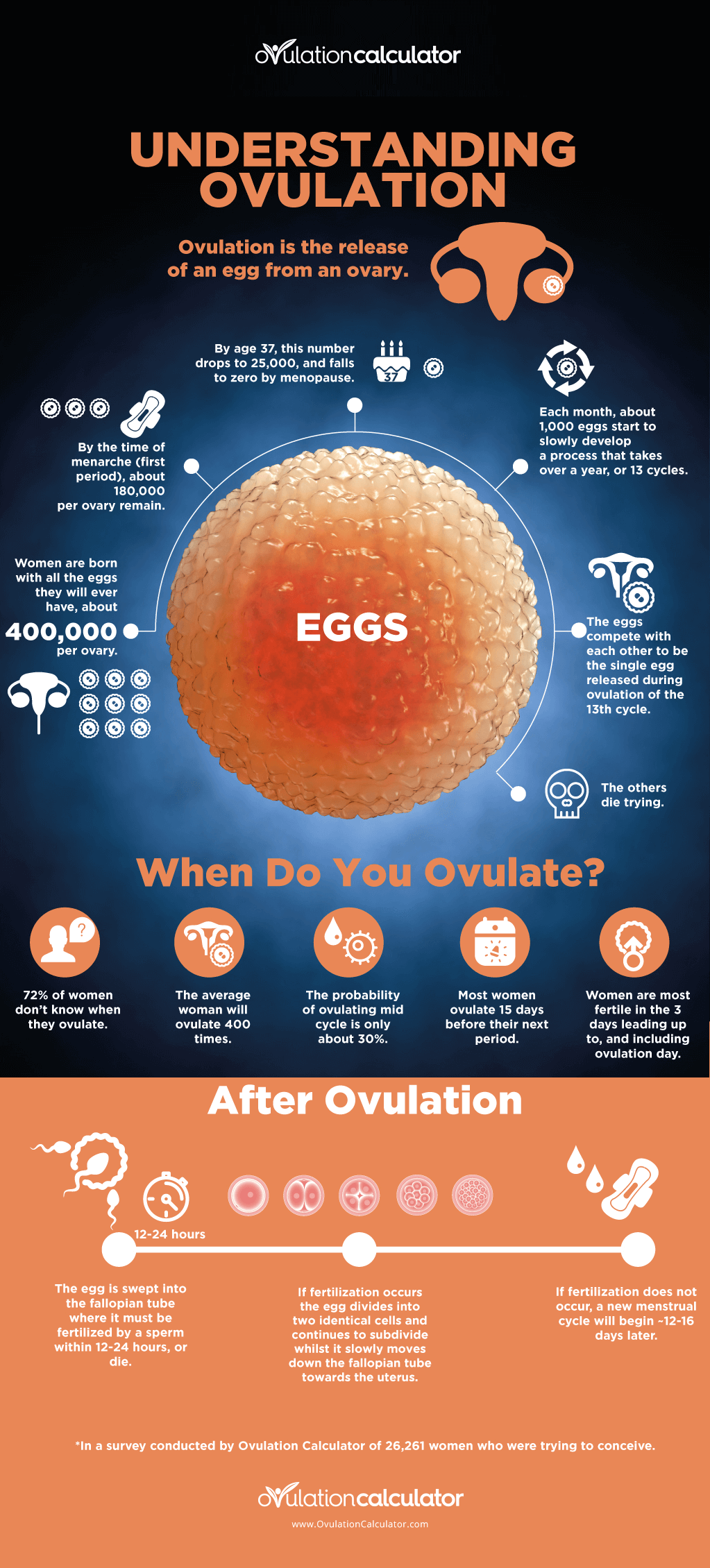
Click here to see a larger view of the image
Embed the Understanding Ovulation infographic on your site (copy the code below):
1: http://www.pnas.org/content/107/22/10280.abstrac
2: http://www.pnas.org/content/107/22/10280.full
3: http://www.ncbi.nlm.nih.gov/pubmed/3558758
4: http://humrep.oxfordjournals.org/content/23/3/699.full
5: http://www.biolreprod.org/content/50/2/225.full.pdf
6: http://www.gfmer.ch/Books/Reproductive_health/Folliculogenesis_and_ovulation.html
7: https://www.ncbi.nlm.nih.gov/pubmed/12671122
8: http://dx.plos.org/10.1371/journal.pone.0008772
9: Women may ovulate two or three times a month. Owen Dyer, BMJ 2003 Jul 19
10: Family planning and age-related reproductive risk. David Utting, Susan Bewley The Obstetrician & Gynaecologist 2011;13:35-41.






